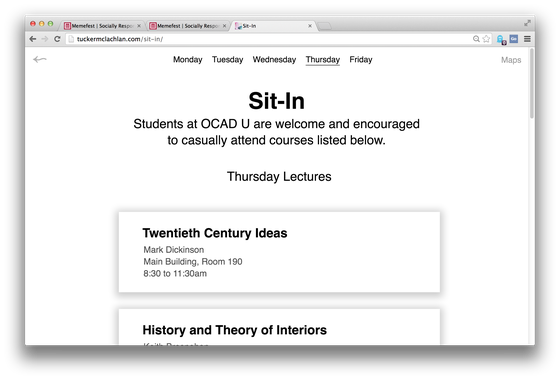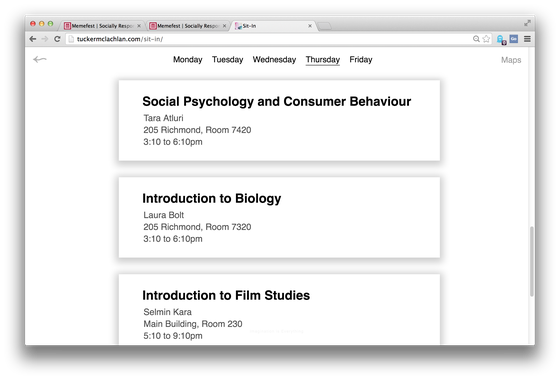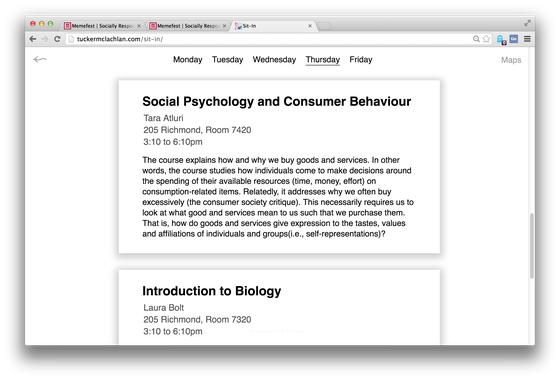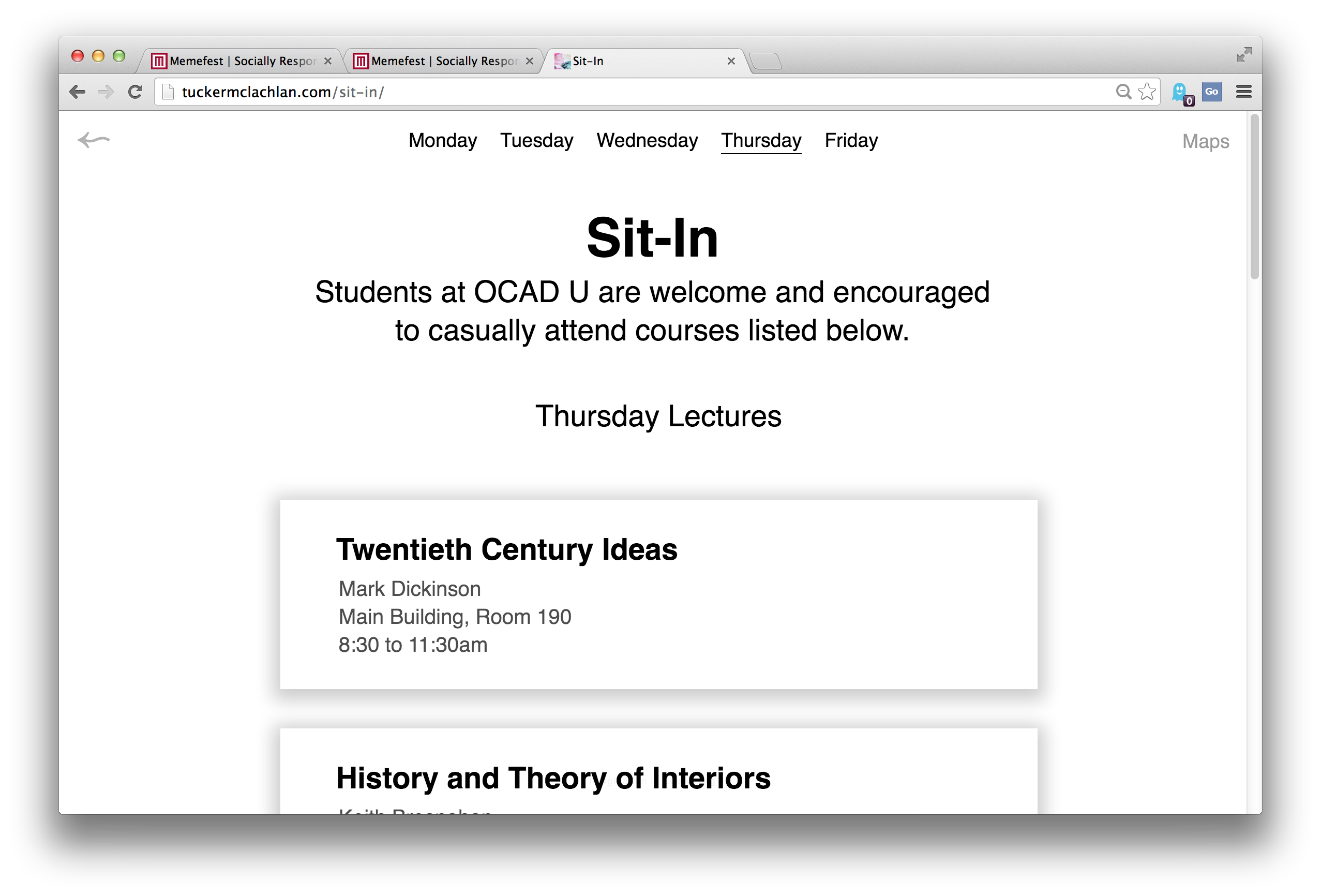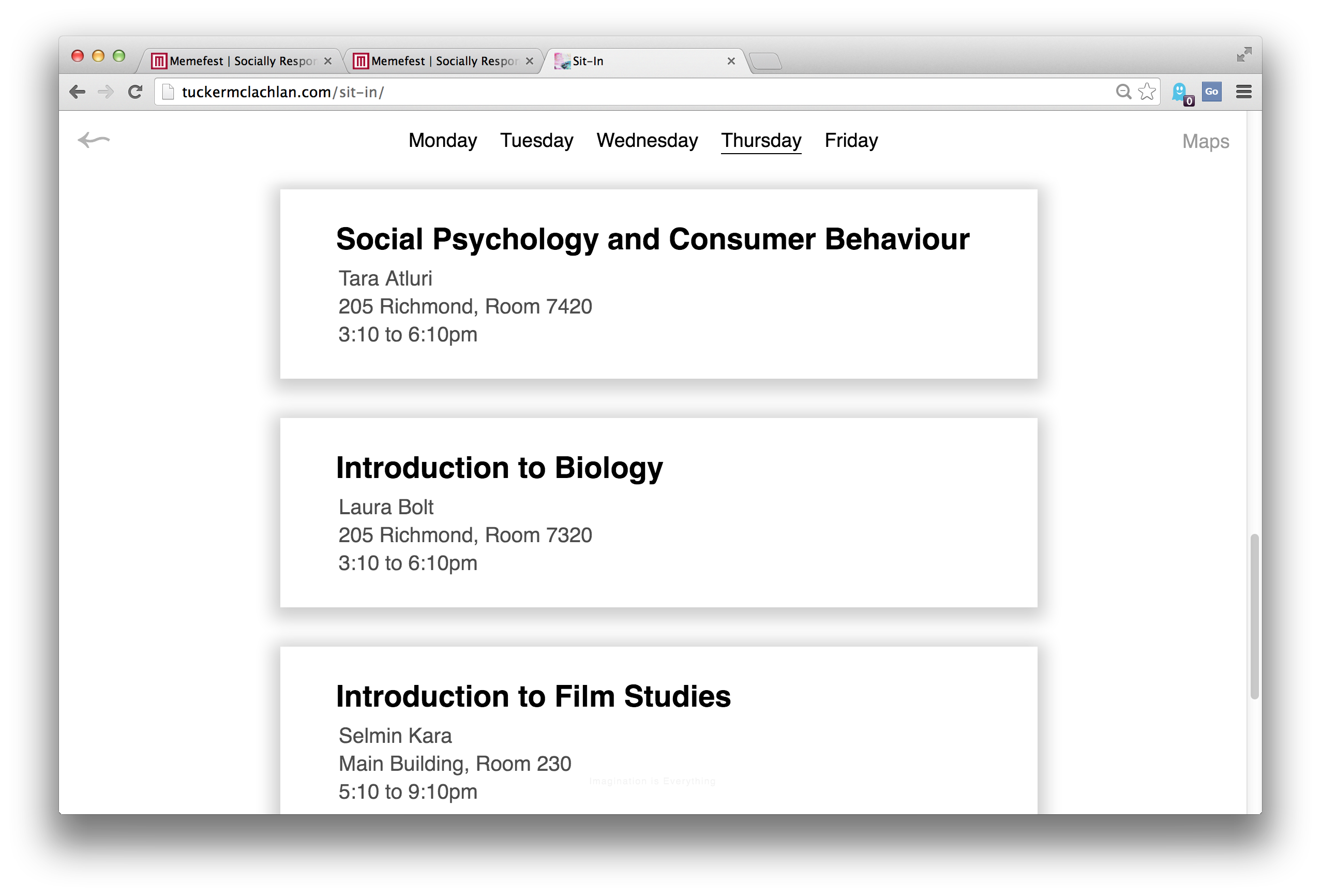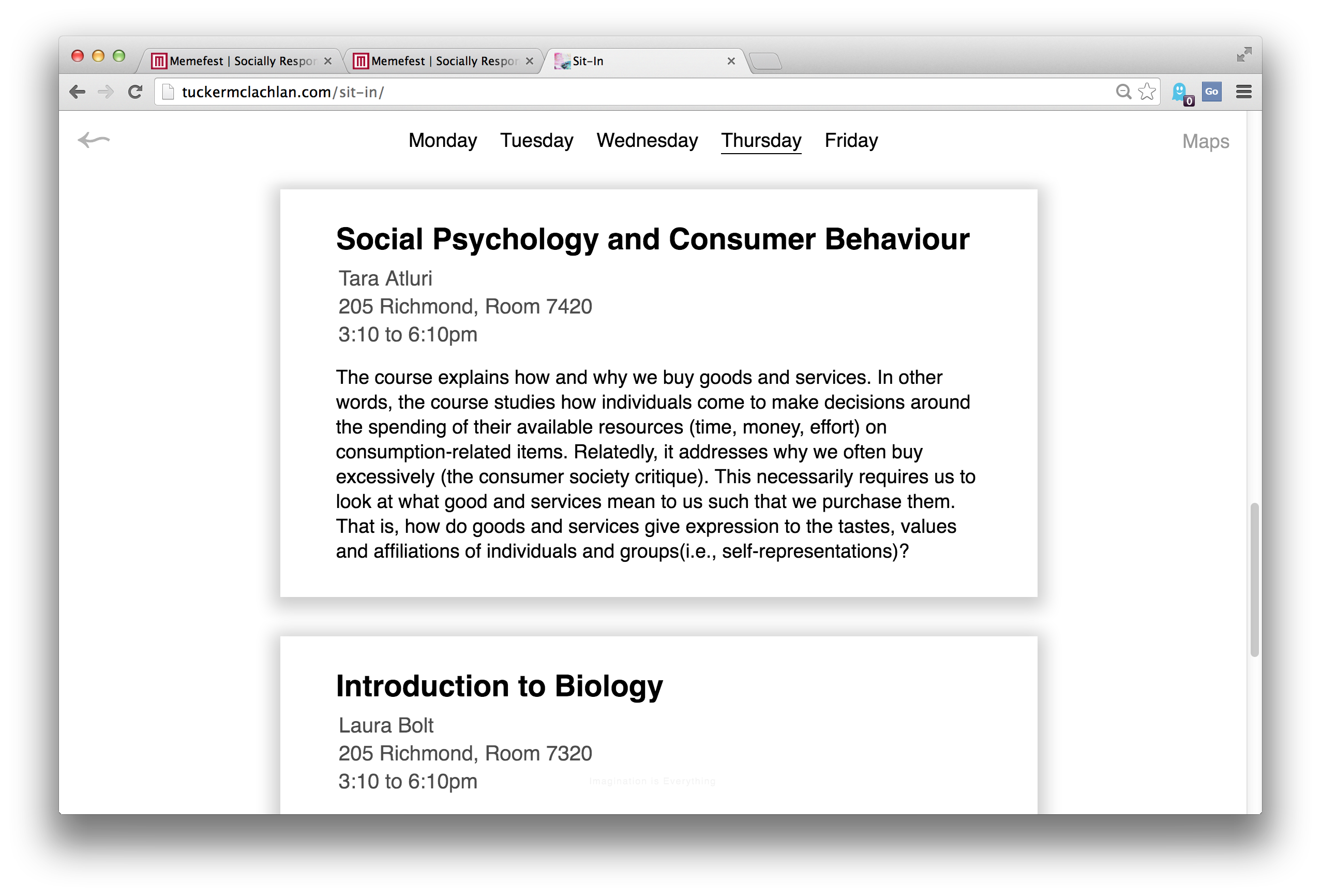Sit-In
by TuckerMCL
This work has been commented by 1 curator(s). Read the comments
Title
Sit-In
Headline
Get to class!
Concept author(s)
Tucker McLachlan
Concept author year(s) of birth
1994
Concept author(s) contribution
Produced the project through from initial idea to designed resource.
Concept author(s) Country
Canada
Other author(s)
Jacqueline Li, Quinn Mantynen, Sheila Sampath
Other author(s) contribution
Sheila Sampath instructed the Think Tank course within which a prototype of Sit-In took shape. Jacqueline Li and Quinn Mantynen contributed valuable thoughts and opinions towards that prototyping process.
Other author(s) Country
Canada
Friendly Competition
Radical intimacies: dialogue in our times (2014)
Competition category
Visual communication practice
Competition subcategory
web / interactive
Competition field
academic
Competition subfield
student
Subfield description
OCAD University / Faculty of Design / Graphic Design Bachelor's Program
Check out the Radical intimacies: dialogue in our times 2014 outlines of Memefest Friendly competition.
Description of idea
Describe your idea and concept of your work in relation to the festival outlines:
The idea of Sit-In is to break down conceptions of course enrolment and non-enrolment in post-secondary spaces, and encourage anyone and everyone to casually attend courses that interest them.
Sit-In itself is an online resource providing a daily schedule of the lecture courses taking place at OCAD U, with information on where and when they will be, what they're about, and a message that 'anyone is welcome and encouraged to casually attend.' This is a project that I would love to see taken up and championed at any school.
As is noted in the 'Four Short Excursions on Dialogue,' standardized language rooted in administration can colour dialogue with economic undertones that limit possibility and determine the rules of engagement between people, systems, and institutions. As a student, I'm very aware of the way that I 'take' 'units' in accordance with my 'courseload' — that I am to engage with the university in which I am 'enrolled' by attending no more than six courses of various subjects pertinent to my 'major' per twelve week semester. In doing so, my engagement with the university is significantly filtered: I am led to participate in only a very small and particular set of the actual, human dialogues underway at OCAD, in all of the classrooms and lecture halls whose schedules of discussion ('History of Modern Art', 'Sociology of the Body,' 'The History and Evolution of Typography'...) I am largely unaware of.
Sit-In is an effort to twist this logic of parcelled-out, reified dialogue into something more exciting, spontaneous, participatory, and conducive to ongoing self-determination. It allows students (and non-students) to circulate throughout the whole of the university more freely, without requiring the level of commitment demanded by enrolling in a course.
As post-secondary institutions begin to offer online and hybrid/online courses alongside traditional, embodied learning experiences, the spaces for dialogue fostered in traditional university settings face new challenges beyond subjection to quantification, measurement and parcelling. Online forms of dialogue do away with the proximity of bodies and their affective potential, as well as with the possibility of chance encounter. As much as digital interactions are replacing embodied ones in many areas of life, their entrance into schools is something I find particularly important to recognize given the role educational institutions have historically played as sites of congregation. Sit-In tries to counter this by bringing everything back to physical, occupiable spaces. As Jonathan Crary has recently written, "If one's goal is radical social transformation, electronic media in their current forms of mass availability are not useless—but only when they are subordinate to struggles and encounters taking place elsewhere. If networks are not in the service of already existing relationships forged out of shared experience and proximity, they will always reproduce and reinforce the separations, the opacity, the dissimulations, and the self-interestedness inherent in their use" (24/7: Late Capitalism and the Ends of Sleep, page 121).
Sit-In affirms that dialogue is meaningful (and only truly qualifies as dialogue) when it is entered into actively.
What kind of communication approach do you use?
Sit-In uses a deliberately neutral communication approach in the interest of appearing legitimate. Scheduled lectures for each day are listed chronologically, from earliest to latest. The web design is responsive to accommodate students and users on phones, laptops, or other devices. The black and white colour scheme follows from OCAD U's branding, and Helvetica is used throughout again in the interest of visual legitimacy. Sit-In's existence has been communicated primarily through word of mouth and through sharing on Facebook and Twitter.
What are in your opinion concrete benefits to the society because of your communication?
Sit-In helps in the effort towards decommodifying education. Very concretely and immediately, it gives people the ability to attend intellectually rich presentations of knowledge that they might not otherwise have access to or seek out. As well, the resource promotes student engagement, cross-fertilization among students of different disciplines, and a more self-determined circulation of bodies within the university that would not be possible without it.
What did you personally learn from creating your submitted work?
I've learned that interface design is a real challenge! I've learned a lot about university room scheduling systems, the value of testing something like this with the people that will use it, and also about the role certain typographic and layout decisions can play in making something look trustworthy.
Why is your work, GOOD communication WORK?
I think Sit-In is good communication work because it intervenes in specific relationships within a particular power structure and *hopefully* gives people more agency.
Where and how do you intent do implement your work?
Sit-In has been implemented at OCAD U, and I would really love to implement it in any other schools that are interested. All that is necessary is a web server and a list of classes.
Did your intervention had an effect on other Media. If yes, describe the effect? (Has other media reported on it- how? Were you able to change other media with your work- how?)
Sit-In has been piloted for the first time this Fall semester, and its effects so far have been very interesting. Sit-In was made available without asking for or receiving expressed permission. It has received a fair bit of attention and excitement from students, was posted on Facebook by the OCAD U Student Union, and received about 15 re-posts. Interestingly, the official OCAD U Twitter account itself tweeted a link to Sit-In, apparently legitimizing it or perceiving it to be legitimate. Subsequently, I received an email from the Dean of Liberal Arts and Sciences requesting that Sit-In be temporarily made unavailable until reservations among faculty be addressed. I have obliged. We will meet to discuss Sit-In this coming Thursday (October 2nd).
Curators Comments
Roderick Grant
I think what is here is a compelling start to a more engaged and critical look at education as a process of continual dialogue initiated by students, not always by institutions. In and of itself, the website establishes some simple facts of courses being taught, their places and locations.
The mode of operation here could be likened to tuition becoming a membership, a subscription, less so a permission to fit into easily filled time-slots. The arguments from online learning and hybrid deliveries reducing face-time and meaningful interactions between students, between faculty, between faculty and students are well placed, but there are further radicalizations to consider here, which could occupy a similar space online.
Sit-in - as a means to occupy spaces of ongoing education - or simply just lectures - is currently defined by what OCAD U has available according to faculty and the courses they are teaching in a given semester. But what of issues that emerge from the student body as necessary points of inflection, attention and reflection? What about a space that aggregates and initiates faculty response to student interest - democracy in Hong Kong one week - infrastructure in Toronto the next?
A question here is: Teach-in vs Sit-in? Is the work, even in its current state, too passive? It points to opportunity, but doesn't necessarily engage need, or alternatives outside of institutionally sanctioned learning. I think this comment is directed at the gap between what you identify richly in the text, but don't yet deliver in the interface and execution: 'Sit-In affirms that dialogue is meaningful (and only truly qualifies as dialogue) when it is entered into actively' - by both parties, not just one.
If the OCAD U course list is an active role in discourse or dialogue, then its a rather one sided dialogue. The fact that the administration has taken note is a good sign, but true dialogue means engaging in a bit of risk, which institutions are in general, loathe to do.
If this is an attempt, a proposal, not just an execution of a schedule, and I can read between the lines, and hope that it is more than it appears, then perhaps in order to be more critical, to achieve some currency in critical pedagogy, what it should start to ask is 'what do students want to know about, and how?'. As hard as that is as a pedagogical road to tread, it remains a necessary one, especially in the design disciplines, where adherence to existing logics can be ultimately dangerous.
If it is an attempt to 'participate in the transformation of the world' (Paulo Freire), then the language used to frame the submission should perhaps also be available on the site - to frame its intent, and purpose, and to allow the dialogue to be about more than the list of available lectures week to week.
Its a solid foundation from which to ask for participation in educational reform, and to seek awareness of the limits of one's knowledge as a lifelong (critical) process.

